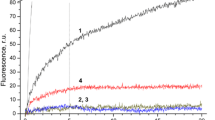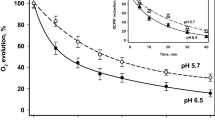Abstract
High rates of hydrogen photoproduction are obtained when glutaraldehyde-fixed Photosystem I-enriched vesicles (Photosystem II-depleted) are added to hydrogenase-containing cells of Proteus mirabilis in the presence of the mediator methylviologen and a suitable electron donating system. This donor system includes ascorbate, dithioerythritol (DTE) and the mediator tetramethylphenylene-diamine (TMPD) and reduces the photosynthetic electron transfer chain at the level of plastocyanin. Both DTE and ascorbate are required for hydrogen photoproduction, DTE being the ultimate electron donor and ascorbate only having a catalytic function. Whereas the aerobic photoreduction of methylviologen is similar in the presence of DTE, ascorbate or both, under anaerobic conditions only combination of both compounds results in a high and stable amount of reduced methylviologen that can be utilized by the hydrogenase. It is concluded that oxidation reactions of reduced methylviologen, competing with the hydrogenase, rather than methylviologen photoreduction, limit hydrogen photoproduction in the presence of either DTE or ascorbate. These oxidation reactions are suggested to involve back reactions to the oxidized form(s) of ascorbate and DTE but backflow to the photosynthetic electron transfer chain (i.e. cyclic electron transfer) can not be excluded.
Similar content being viewed by others
Abbreviations
- Tes:
-
N-tris (hydroxymethyl) methyl-2-aminoethanesulfonic acid
- DTE:
-
1,4-dithioerythritol
- TMPD, N,N,N′:
-
N′-tetramethyl-p-phenylenediamine
- DCMU:
-
3-(3′, 4′-dichlorophenyl)-1, 1,-dimethylureum
- EDAC:
-
1-ethyl-3-(3-dimethylaminopropyl)-carbodiimide
- DNP-INT:
-
2-iodo-6-isopropyl-3-methyl-2′, 4, 4′-trinitrodiphenyl ether
- DBMIB:
-
2,5-dibromo-3-methyl-6-isopropyl-benzoquinone
- PS:
-
photosystem
- Chl:
-
chlorophyll
References
Adams MWW, Mortenson LE and Chen J-S (1981) Hydrogenase. Biochim Biophys Acta 594: 105–176
Arnon DI, Mitsui A and Paneque A (1961) Photoproduction of hydrogen gas coupled with photosynthetic phosphorylation. Science 134: 1425
Ben-Amotz A and Gibbs M (1975) H2 metabolism in photosynthetic organism. Light-dependent H2 evolution by preparation from Chlamydomonas, Scenedesmus and spinach. Biochem Biophys Res Commun 61, 355–359
Benemann JR, Berenson JA, Kaplan NS and Kamer MD (1973) Hydrogen evolution by chloroplast-ferredoxin-hydrogenase system. Proc Natl Acad Sci USA 70: 2317–2320
Bernstein JD and Olson JM (1981) Photoreduction of hydrogen by membranes of green photosynthetic bacteria. In Akoyunoglou G, ed. Photosynthesis Vl. pp. 675–680. Philadelphia: Balaban International Science Services
Bruinsma J (1961) A comment on the spectrophotometric determination of chlorophyll. Biochim Biophys Acta 52: 576–578
Cleland WW (1964) Dithiothreitol, a new projective reagent for SH groups. Biochemistry 3: 480–482
Cuendet P and Gratzel M (1981) Photoproduction of H2 from isolated chloroplasts through ultrafine Pt catalysts and different viologen relays. Photobiochem Photobiophys 2:93–103
Fry I, Papageorgiu G, Tel-Or E and Packer L (1977) Reconstitution of a system for H2 evolution with chloroplasts, ferredoxin and hydrogenase. Z Naturforsch 32c: 110–117
Gisby PE and Hall DO (1981) Biophotolytic hydrogen production using alginate immobilized chloroplasts, enzymes and synthetic catalysts. In Akoyunoglou G, ed. Photosynthesis VI, pp. 655–664, Philadelphia: Balaban International Science Services
Hauska GA, McCarty RE and Racker E (1970) The site of phosphorylation associated with Photosystem I. Biochim Biophys Acta 197: 206–218
Hauska GA, Reimer S and Trebst A (1974) Native and artificial energy-conserving sites in cyclic photophosphorylation systems. Biochim Biophys Acta 357:1–13
Hoffmann D, Thauer R and Trebst A (1977) Photosynthetic hydrogen evolution by spinach chloroplasts coupled to a Clostridium hydrogenase. Z Naturforsch 32c: 357–362
Izawa S, Kraayenhof R, Ruuge EK and Devault D (1973) The site of KCN inhibition in the photosynthetic electron transport pathway. Biochim Biophys Acta 314: 328–339
Karube L, Matsunaga T, Otsuka T, Kayano H and Suzuki S (1981) Hydrogen evolution by co-immobilized chloroplasts and Clostridium butyricum. Biochim Biophys Acta 637:490–495
Kraayenhof R, Schuurmans JJ, Valkier LJ, Veen JPC, Van Marum D and Jasper CGG (1982) A thermoelectrically regulated multipurpose cuvette for simultaneous time-dependent measurements. Anal Biochem 127, 93–99
Krab K, Boog R and Peters FALJ (1984) Biophotolysis: generation of lowpotential reducing equivalents by Photosystem I-enriched subchloroplast vesicles. In Sybesma C, ed. Photosynthesis, in press. Brussel
Krab K, Oltmann LF and Stouthamer AH (1982) Linkage of formate hydrogenlyase with anaerobic respiration in Proteus mirabilis. Biochim Biophys Acta 679:51–59
Krasnovsky AA, Van Ni C, Nikandrov VV and Brin GP (1980) Efficiency of hydrogen photoproduction by chloroplast-bacterial hydrogenase systems. Plant Physiol 66:925–930
Law MY, Charles SA and Halliwell B (1983) Glutathione and ascorbic acid in spinach (Spinacea oleracea) chloroplasts. Biochem J 210:899–903
Lowry OH, Rosebrough NJ, Farr AL and Randall RJ (1951) Protein measurement with the Folin phenol reagent. J Biol Chem 193:265–275
McCarty RE (1974) Inhibition of electron transport in chloroplasts between the two photosystems by a water-soluble carbodiimide. Arch Biochem Biophys 161: 93–99
Muallem A and Hall DO (1982) Ascorbate as a substrate for photoproduction of hydrogen by Photosystem I of chloroplasts. Plant Physiol 69:1116–1120
Packer L and Cullingford W (1978) Stoichiometry of H2 production by an in vitro chloroplast, ferredoxin, hydrogenase reconstituted system. Z Naturforsch 33c: 113–115
Peters FALJ, Van Wielink JE, Wong Fong Sang HW, De Vries S and Kraayenhof R (1983) Studies on well-coupled Photosystem I-enriched subchloroplast vesicles. Content and redox properties of electron transfer components. Biochim Biophys Acta 722, 460–470
Rao KK, Rosa L and Hall DO (1976) Prolonged production of hydrogen gas by a chloroplast biocatalytic system. Biochem Biophys Res Commun 68:21–28
Rosen MM and Krasna AI (1980) Limiting reactions in hydrogen photoreduction by chloroplasts and hydrogenase. Photochem Photobiol 31:259–265
Trebst A (1980) Inhibitors in electron flow: tools for the functional and structural localization of carriers and energy conservation sites. Meth Enzymol 69: 675–715
Wang R, Healy FP and Myers J (1971) Amperometric measurement of hydrogen evolution in Chladynomonas. Plant Physiol 48:108–110
West J and Packer L (1970) The effect of glutaraldehyde on light-induced H+ changes, electron transport and phosphorylation in pea chloroplasts. J Bioenerget 1, 405–412
Author information
Authors and Affiliations
Rights and permissions
About this article
Cite this article
Peters, F.A.L.J., Boog, R., Krab, K. et al. Efficiency of hydrogen photoproduction by photosystem I-enriched subchloroplast vesicles combined with Proteus mirabilis cells. Effects of some exogenous electron donors. Photosynth Res 5, 335–346 (1984). https://doi.org/10.1007/BF00034978
Received:
Revised:
Issue Date:
DOI: https://doi.org/10.1007/BF00034978




